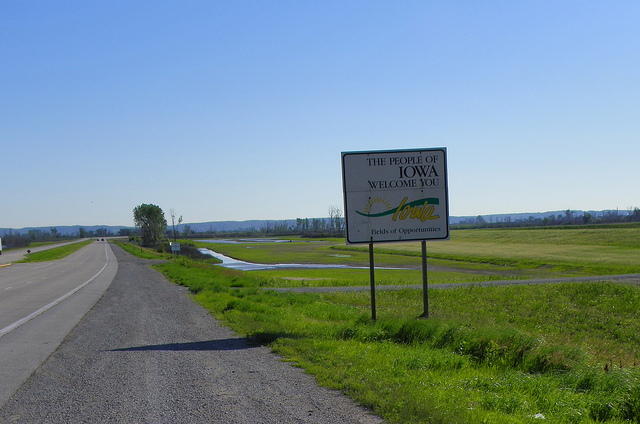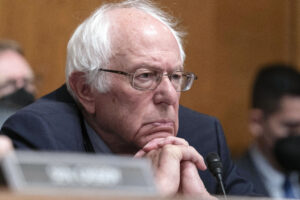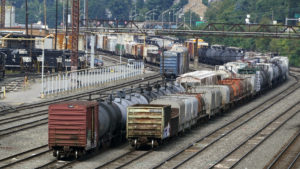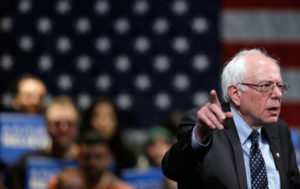Radical Changes Are Coming to the Iowa Caucuses
As many as 100,000 additional voters could participate next year, potentially altering the course of the 2020 Democratic primary. J. Stephen Conn / Flickr
J. Stephen Conn / Flickr
The Iowa Democratic Party is preparing to implement the most sweeping and radical changes to its first-in-the-nation caucuses in 50 years, including potentially adopting online elements that could increase participation by upward of 100,000 voters, according to party leaders.
“We have spent many, many months and thousands of hours of conversations with a whole lot of different folks about what is the best solution. And we’re in the process right now, literally this month, of crafting that into a draft of a delegate selection plan,” Iowa Democratic Party executive director Kevin Geiken said Thursday.
“We’re down to about three choices,” he said. “We’re down to an absentee ballot system. We’re down to a proxy system. We’re down to a tele-caucus system. I would venture to say that we are even down to two potential solutions, because the absentee ballot process is so complicated logistically that I just don’t think that is a viable solution for us.”
Iowa party officials have not formally decided what options to pursue, he emphasized. But a detailed discussion with Geiken and Democratic National Committee officials is strongly pointing to the likelihood that Iowans will be able to participate in 2020’s caucuses using online tools.
Iowa’s 2020 caucuses were already going to be historic and pose logistical challenges for party officials, given a field of a dozen or more candidates. But implementing the new DNC 2020 Delegate Selection Rules—which articulate broad goals such as same-day registration and remote participation without specifying how to accomplish those requirements—adds layers of election administration complexity for the Iowa party. (The party is not a state or federal government agency routinely running elections.)
Geiken said the party is hoping this month to complete its report assessing these options and then move toward working out the considerable details to implement their plan at caucuses to be held in Iowa’s 1,679 precincts. The DNC must approve each state’s procedures.
In 2016, there were 171,500 participants in Iowa’s Democratic caucuses—out of 629,000 registered Democrats in the state. Iowa has similar numbers of independents (no declared party) and Republicans. Iowa’s GOP uses a straw poll for its presidential nominating process.
The mix of offering same-day registration to any voter willing to join the party and an ability to remotely caucus will pose unprecedented outreach, organizing and turnout possibilities for Democratic candidates. When asked if the 2020 participation rates could double or triple, Geiken didn’t blink.
“I absolutely think it’s realistic,” he replied. “Because we will have the non-present participation and we will have solved that [means of doing so] by then. I think it will open it up for another 100,000 people to participate right there.”
The changes coming to Iowa’s Democratic presidential caucuses will be the first big makeover in a half-century. After 1968’s violence-plagued national convention in Chicago and electoral rout that fall, the DNC made Iowa’s caucuses and New Hampshire’s primary their lead-off contests. In 1976, a relatively unknown Georgian, the state’s ex-governor, Jimmy Carter, won Iowa after spending months traveling the state and speaking to locals. Presidential contenders have followed that same template ever since.
The biggest challenge is not what will likely draw the early headlines: that Iowa likely will be conducting online voting in 2020’s caucuses. Nor will it concern what online technology, vendor, security and authentication would be used. Instead, the party will have to create a counting process where the votes coming into its 1,679 caucus sites are electronically tabulated in an open and coordinated fashion with each round of voting in the caucus sites—where participants break off into groups for each candidate.
Under Iowa’s caucus rules, presidential candidates with less than 15 percent of the votes are excluded from subsequent voting rounds. The caucus ends when all of the remaining contenders are above that threshold. In a typical caucus, supporters of the apparently marginal candidates realign with others, literally by moving across the room to join other groups as the voting continues. To keep this event’s spirit alive, which the Iowa party and DNC say is crucial, the participation and tabulation of voting has to be sequential, coordinated, transparent and verifiable.
“That’s a big challenge, and I think you are further ahead in thinking about this than most people who are caucus participants,” Geiken told this reporter. “Certainly not further ahead than we are of thinking about the problems that we have to solve. I don’t know what the actual answer will be with how this manifests on February 3 or earlier, if we start the [remote] participation process earlier. But those are the considerations we are putting into this.”
Geiken cited one example of the details associated with caucusing online.
“Let’s say we do a tele-caucus or an online caucus and we have it available starting the week before February 3. Just as an example here,” he said. “In order for us to feel comfortable going down that path, we would have to make sure there is a provider out there, a vendor out there, that can do that in a way that allows pre-registration, so we can see who is planning to participate on February 1, for example, at 7 p.m., versus February 1, at noon.”
Geiken said the process has to screen for people trying to vote more than once, keep track of who may have participated in early voting, make sure no one who participates is a Republican (unless they join the Democratic Party) and make sure the technology is secure. “That it is an unhackable” process, he said, “and I don’t know if there’s ever anything that’s unhackable.”
And all of these details are preludes to tabulating the votes, including what’s likely to be untold thousands of first-time caucus participants.
The DNC’s 2020 Rules
In late December, the Democratic Party released their 2020 Delegate Selection Rules to encourage greater participation in 2020’s presidential caucuses and primaries.
The guidelines came after a two-year “Unity Reform” process triggered by the contentious 2016 race between Hillary Clinton and Bernie Sanders. For caucuses, the rules require voting by mail and/or online for voters who are not physically present. The rules also require same-day registration to lift participation. The DNC is leaving it up to state parties to figure out what specific protocols and technologies would be used. State parties are to submit their plans later this spring to be approved by the DNC.
For example, the Iowa party will have to design some kind of ballot or an interactive template for remote participants. That design, in an Iowa-style caucus, would likely resemble ranked-choice voting, several officials said. The DNC rules also leave to state parties to orchestrate the counting, which, in a modernized caucus, could involve multiple voting systems. The rules also require a capacity to audit and undertake recounts.
National party officials say there are precedents for caucus states to use online voting or absentee ballots. Michigan used online voting in its 2004 caucuses. In 2016, Utah Republicans used online voting in the state’s presidential caucus. That year, Washington state and Nebraska used mail-based voting in their Democratic caucuses.
While the DNC is bullish about their 2020 reforms, government officials with experience administering elections are skeptical that so many changes can be well executed the first time they are introduced. A Florida election supervisor—now retired after decades of running elections in that state’s capital county—had a one-word reply when asked what could go wrong: “Everything!” he said. The first concern cited by a former state election director from a blue state was “authentication,” which refers to confirming voter identity and is part of the foundation for ballot security and custody.
There are recent examples of Iowa presidential contests naming a disputed winner. The top example is not 2016’s virtual tie between Sanders and Clinton—with the party announcing Clinton won 700.47 delegate equivalents to the process’s next stage, compared to 696.92 for Sanders, but not releasing raw votes. In 2020, the caucus totals will be released.
In 2012, the early results of the Republican straw poll declared that Mitt Romney had won, until it emerged that Rick Santorum actually had more votes. By then, however, Romney had grabbed the momentum, including invaluable coverage that he was the GOP’s frontrunner. (Notably, a straw poll is simpler than what the DNC is asking of its caucuses in 2020.)
Nonetheless, top DNC officials are committed to reforming caucuses.
“Let me tell you how I think about that working,” said James Roosevelt III, the longtime co-chair of the DNC Rules and Bylaws Committee, which issued the 2020 rules. “Again, this is speculation, because states are going to have to innovate and figure out how they [will] do this. But the way I think about this, you have a first round of voting in Iowa City. The people [who are there] in person vote, at least as I have seen it on C-Span, by all going to different corners of the room and so on. The organizers will also have ballots that will have come in. I think that they’ll need one single [counting] method.”
“They either need to have printed out the electronic ballots [from voting online] and count them on paper, or they digitize the mail ballots, and do them all that way,” he said. “But they will, again, count the number one choices toward that total for the first round. What happens after the first round, as you know, is people who don’t reach the threshold reallocate themselves. The same thing will have to be done with the paper or digital ballots. They will have to be reallocated to number two choices.”
Roosevelt said that the new DNC rules do not require using ranked-choice ballots, which is where voters select candidates in descending order, which is simple. Tabulating ranked choice contests is more complex, however, as ballots must be carefully scrutinized when the top choices are no longer relevant and other candidates are disqualified.
“It is possible to have a computer program to do this [tabulation], because that is what we do in Cambridge,” Roosevelt said. “After 40 years of doing this by hand, Cambridge converted to a computerized process that does seven or eight rounds in about two hours. However, Maine, which did not spend the money on the computerized process, did it by hand. And that works too.”
Iowa’s Options
Geiken, the Iowa Party’s executive director, recounted the pluses, minuses and challenges in every approach to bring remote participation to the 2020 caucuses. There are three main pathways: using some form of absentee balloting or voting via the mail; having voters who are not present sign some version of a proxy allowing someone else who is present to cast their vote; or having an online platform where voters can participate remotely.
“To be completely honest, none of these potential solutions is perfect,” Geiken said. “There’s going to be some challenges with each of them—with the execution. We are now looking at which solution checks all the boxes—leads to transparency, efficiency, fairness, matches the spirit of the caucus, maintains the spirit of the DNC rules, and creates the least amount of fallout problems.”
Voting by mail raises red flags, Geiken explained. To start, the state party must pass what he called “a New Hampshire test,” which means the caucus cannot be turned into a primary election—as New Hampshire is as strongly committed to being the first primary state as Iowa is committed to being the first caucus state. That means the Iowa party cannot urge every registered Democrat to request an absentee ballot to caucus by mail.
Going a bit deeper, even if the Iowa party wanted to offer that option—and Geiken said that county election officials have been telling him this is not easy to administer—there is the question of ballot design. What does that ballot look like so that it gives participants a way to revise their choice in sync with the successive rounds of caucus voting? Also, tabulating mail ballots with the in-person numbers generated in 1,679 caucus sites across Iowa is quite a logistical challenge.
“The feedback we have gotten from a lot of county auditors [who run Iowa’s elections] is to avoid absentee ballots as much as possible,” he said. “They talk about the horrors they have seen. They have perfected it [their process]. But they have the whole support of the state and state government behind them. We don’t.”
The second option for remote participation would be some form of proxy. There are two possible approaches, Geiken said. Either the attendee holding another Democrat’s proxy is “restricted” with who they can vote for, or they are “unrestricted.” However, as soon as the voting goes into successive rounds, it’s inevitable that an attendee holding multiple proxies will be expected to be in more than one candidate’s camp—which is physically impossible.
There are other complications with using proxies, he said. The party has thought about limiting how many proxies an attendee can hold. Geiken said he could envision campaign volunteers going door-to-door to collect proxies and then show up at caucuses. There is some possibility of undue pressuring of people to sign over their votes, he said. There’s also a potential to create different classes of caucus-goers—literally super-voters.
“What you are doing in the caucus room is you are creating different levels of caucus-goers,” he said. “There’s the quote-unquote regular caucus-goer who is representing him or herself. But now there is the person who is representing two votes or maybe 20 votes. And from a campaign advantage, what will the campaigns do to use this to their individual advantage?”
Logistically, proxies present other challenges—even if they are restricted and akin to a ranked-choice ballot, Geiken said. “If you carry my proxy, you sign in [at the caucus site]. You give them the proxy piece of paper. If it’s a ranked-choice system, that can happen on paper now. But the thought of doing that in 1,679 precincts… now you’re devoting at least two volunteers [at each site] to shuffling paper around for the hour.”
The third option for remote participation is using an online platform, Geiken said. While there are many coordination issues to be worked out surrounding authentication of voters, the sequencing of votes, tabulation and balloting records (for transparency and recounts), it was becoming clear that some version of an online interface offered the most flexibility for users and party officials —and that interactivity matches the pace and caucus process.
“The tele-caucus system is most in line with the spirit of the caucus,” he said. “You show up. You still participate. But we are now opening up the opportunity to participate to the Friday before at 5 p.m. Or maybe Wednesday at 2 a.m. for the second shift workers or the third shift workers, so they can participate. But it still relies on them participating. We can then see it. We can then control it. The technology is there even now to have people put on their webcam and show them caucusing. There’s a potentially nice visual element for that.”
While there are many critics of online voting, there is one central feature in caucuses that makes the security challenges somewhat more manageable and akin to online banking. That key feature is Iowa’s caucus participants are not casting anonymous votes—unlike the November election. Thus, there are many tools available to confirm a voter’s identity and track online voting choices while guarding against electronic ballot box stuffing.
However, integrating the online tabulations with the rounds of physical voting at every caucus site will be challenging—requiring a sophisticated infrastructure. In election administration, generally speaking, new systems are not first deployed in the most high-profile and high-stakes races, because unintended errors are inevitable.
Iowa’s Democratic Party doesn’t have any comparable contest for test runs, a technical expert with Iowa’s Secretary of State office said. (That office is currently in GOP hands and does not have a history of assisting the state Democratic Party in administering caucuses.)
Geiken said the manpower and training challenges present an opportunity, because large numbers of Iowa Democrats are uniquely dedicated to their presidential caucuses. But that is further down the road. The next stage of this planning process—after the state party formally decides what remote voting pathway to take—is working with vendors to customize the needed technology. The DNC has set goals and the state must meet them, he said.
“That’s exactly where we are,” Geiken said. “But it is the right thing to increase participation.”
Even Roosevelt, who has been DNC Rules Committee chair for more than two decades, said the 2020 rules were “uncharted territory.” The DNC hasn’t been talking to private vendors or technical consultants, he said, because that is up to the states—as Iowa will soon do.
“We have not really talked to those people because it is up to the states to explore what methods they want to use,” Roosevelt said. “I would say that we are in somewhat uncharted territory here. We might end up for the next cycle having best practices that we have learned from various states in this issue. It’s probably true that Iowa is going to be the test of this, one way or another, since they are the truest caucus operation. I know that they are thinking actively on how to do this.”
Roosevelt said the DNC would encourage caucus states to do test runs, but elections, despite the best of intentions, inevitably have hiccups. However, there are few contests in the American political world that are as high profile and have as high stakes as the Iowa presidential caucuses.
“We did test runs on electronic voting when we chose the DNC chair two years ago. The test runs were all great. When we got to it [the actual vote], we had to go to paper ballots because the electronic system didn’t work when everybody was online,” he said, then laughing.
“We know, from all IT [information technology], we’ll get to a point where there’s a version that really works the way we envisioned it. But it probably isn’t 1.0 or 2.0.”
This article was produced by Voting Booth, a project of the Independent Media Institute.
Independent journalism is under threat and overshadowed by heavily funded mainstream media.
You can help level the playing field. Become a member.
Your tax-deductible contribution keeps us digging beneath the headlines to give you thought-provoking, investigative reporting and analysis that unearths what's really happening- without compromise.
Give today to support our courageous, independent journalists.






You need to be a supporter to comment.
There are currently no responses to this article.
Be the first to respond.